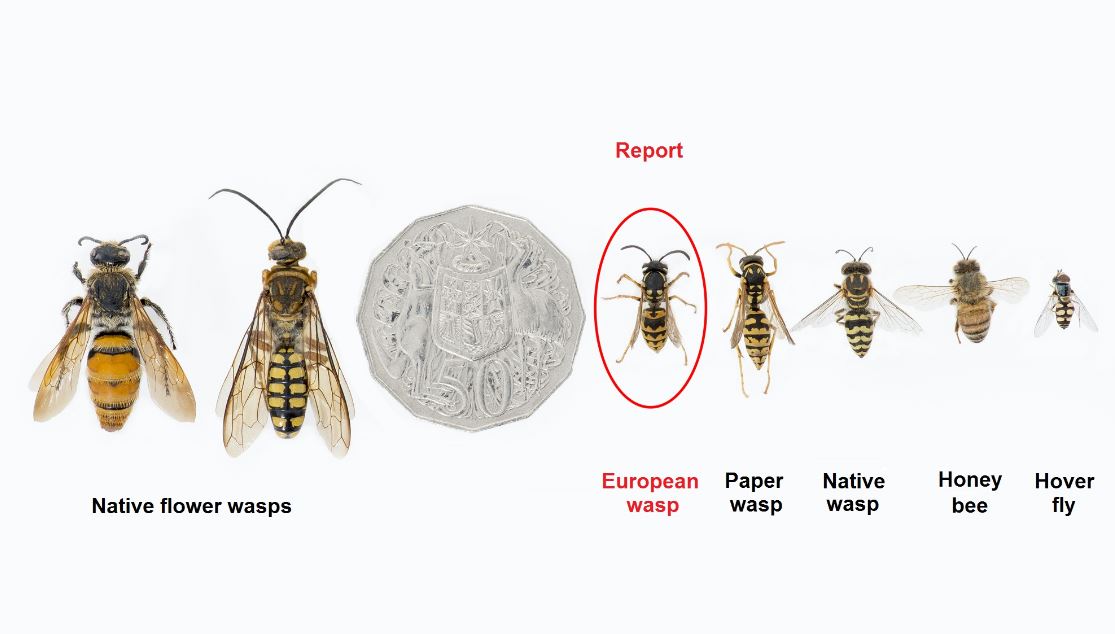
Image source: The Victorian State Government's Health.Vic website.
A European wasp has a long body, is bright yellow in colour and has black stripes.
Wasps on council land - We will remove wasp infestations from Council land. If you locate a wasp nest on council land please contact us on (03) 5772 0333.
Wasps on private land - It is your responsibility to treat wasp infestation on your own property. You can hire the services of a pest controller or treat the problem yourself with products from hardware stores or supermarkets.
Treating a wasp nest:
- Always treat the nest at night when wasp activity is low
- Cover your torch with red cellophane as insects cannot see red light
- If possible, position the torch some distance from yourself, yet still illuminating the area to be treated
- Always wear loose clothing, fully covering your body, a floppy hat or veil and gloves
- Tell someone what you are doing and where you will be
Click here(PDF, 428KB) to download PDF instructions on making a queen European Wasp trap.
Click here to watch a 'how to' video on making a queen European Wasp trap.
A bee is round with orange and black stripes.
Bees on council land - We will remove bee infestations from our own land. If you locate a bee swarm or active bee hive on council land please contact us on (03) 5772 0333.
Bees on private land - It is your responsibility to remove or eradicate bee swarms or hives from your own property. You can hire the services of a private pest controller via the information below.
- yellowpages.com
- Bee information line - 1902 241 059 (the cost of this call is $2.20 per minute including GST, and extra from a payphone or mobile phone)
Bee swarms - Bees are gentle and usually only sting in self-defence. When bees travel in a large group it’s called a swarm. A swarm of bees may stay in the one area for up to two to three days. If you are concerned about a bee swarm, contact the bee information line 1902 241 059 for advice or a licensed pest controller to remove it. You should not attempt to remove a bee swarm yourself.
The Department of Agriculture is the relevant authority for dealing with locust issues.
The Australian Plague Locust (APL) has been declared an exotic pest under the Plant Health and Plant Products Act 1995. Landholders and land managers have an obligation to report locust activity on their land by calling the Locust Hotline on 1800 635 962.
The APL is similar in appearance to grasshoppers. The adult can be identified by the large dark spot on the tip of the hind wings and the distinctive red shanks on the hind leg. Other species may have coloured portions of the hind wing but in different places. The body colour varies; it can be grey, brown or green.
Information including how and when to treat locust infestations is available by visiting the Department of Agriculture website at agriculture.gov.au or calling the Locust Hotline on 1800 635 962.
Image source: Agriculture Victoria
Queensland Fruit Fly is an Australian insect capable of making some fruits and vegetables inedible. Threatening Australia’s $9 billion horticultural production, producers around Australia spend hundreds of millions of dollars on control programs.
Affected fruit is not suitable for sale, making remaining fruit more expensive. Rigorous quarantine conditions limit market access opportunities for sellers.
Locally we have a number of commercial enterprises that actively monitor and engage techniques for detection and management. In the home garden, the presence of fruit fly in your area limits the range of produce which can be grown without using fruit fly control methods.
Managing Queensland Fruit Fly in your garden can be a challenge, however as with all pests, there are various strategies you can implement to protect your home-grown produce.
Control methods are not necessarily expensive or difficult, but they do require time and commitment. There are numerous management strategies the home gardener can engage depending on the growth stage of susceptible plants.
Tips for controlling Queensland Fruit Fly:
Exclusion: Place physical barriers over trees and plants to prevent QFF reaching the fruit. Effective options include netting, gazebos, bags and these are available from your local nursery or hardware retailer.
Good garden hygiene: Pick fruit and vegetables as they ripen. Unwanted produce and produce that has fallen or is rotten, must be placed in a sealed plastic bag and left for five to seven days in the sun to destroy QFF larvae. Do not add unwanted fruit to your compost or worm farm or place it directly into your rubbish bin.
Regular monitoring: Most fruit is attacked by QFF as the fruit matures so regular monitoring is important. You can do this by using traps or by checking for fruit damage or stings on fruit surfaces.
Baiting and trapping: Traps and baits targeting QFF before they attack fruit can be purchased from hardware stores, nurseries and online. Look for traps that will kill both female and male flies.
Insecticide control: Insecticides that kill QFF are available from local chemical or home garden retailers.
For more information on QFF, please go to: